
What Does A White Paper Look Like?
Your white paper needs to be easy to navigate. Sections should naturally lead into each other. Use formatting to make your white paper skimmable, and graphics to draw attention to the key points you’re making.
Here are the key components
white papers typically have:
- Title page
- Table of contents
- Executive summary
- Introduction
- Sections and subsections
- Graphics, charts, and/or sidebars
- One-pagers
- About your company
- References

Align Your White Paper To Strategic Business Values
1. Know Your Audience
“Write for pay scale, not demographics.” This is what Jimmy Daly, co-founder of
Superpath, wrote
in an Animalz article. Pay scales define how tactical or strategic the information needs to be to appeal to your target reader:
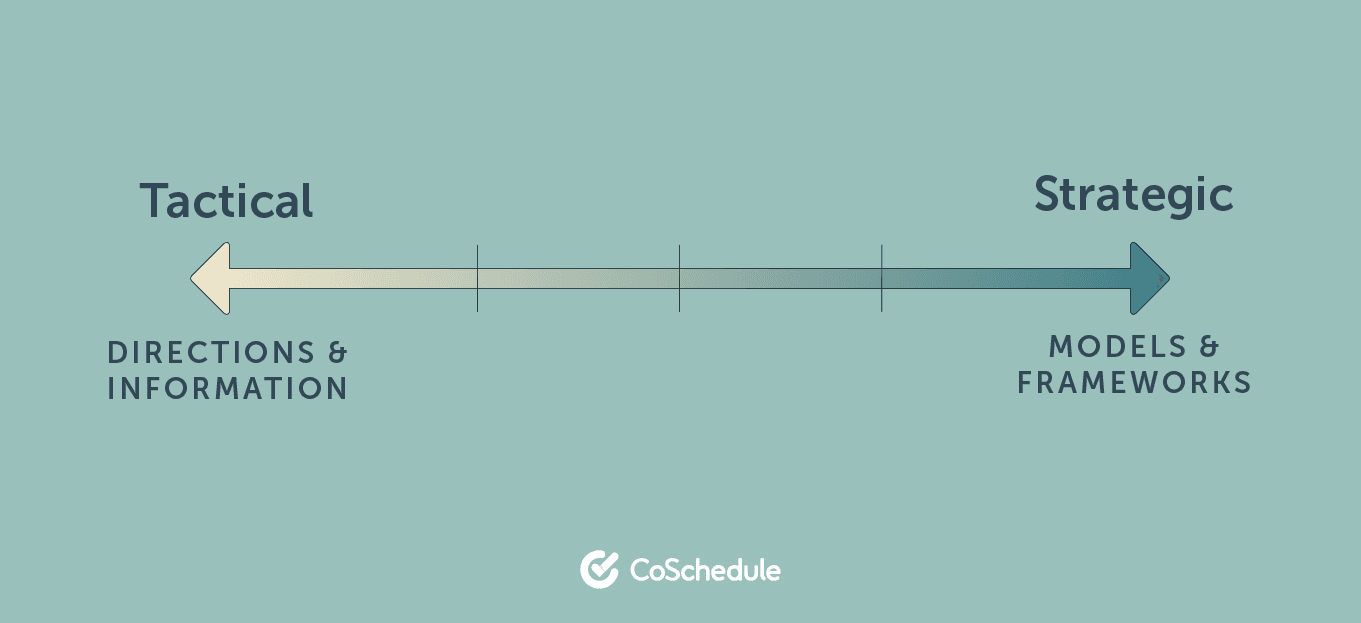
This means that your target reader needs different types of information within the same topic depending on whether they’re a leader or an implementer. Leaders need strategy and frameworks to think within, while implementers need hands-on tactics and directions.
To learn more about your target audience, we recommend reading:
- How to Find Your Target Audience
- How to Create a Marketing Persona
2. Know Your Business Expertise & Strengths
White papers are a form of thought leadership — content that positions your business as a reputable source in your industry. They give you the chance to highlight your strengths.
But, how do you know what subject areas your business excels at? Perform a
SWOT analysis.
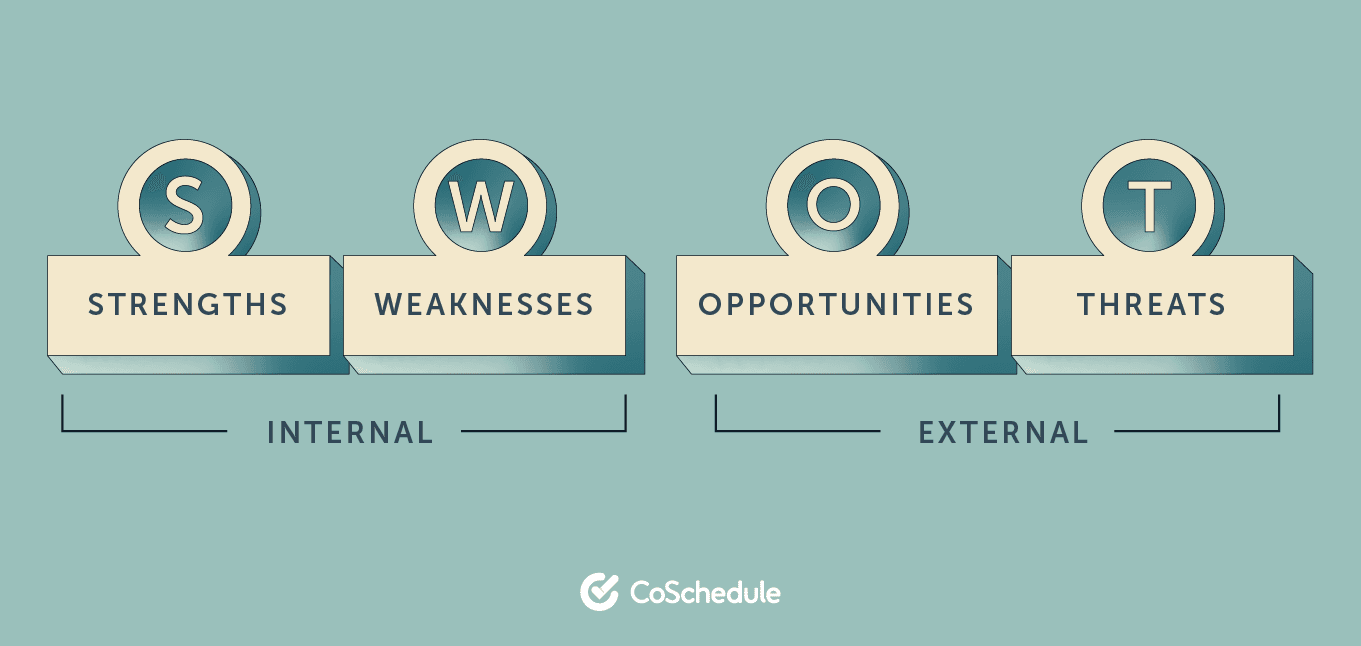
During a SWOT analysis, you identify the strengths, weaknesses, opportunities, and threats your business faces. You can stick to the strengths and opportunities when you perform one to identify your expertise.
Think about the topics you know more about than your competition (strengths), and brainstorm subjects your competition doesn’t cover (opportunities).
3. Choose A Topic That Intersects Audience Needs & Business Strengths
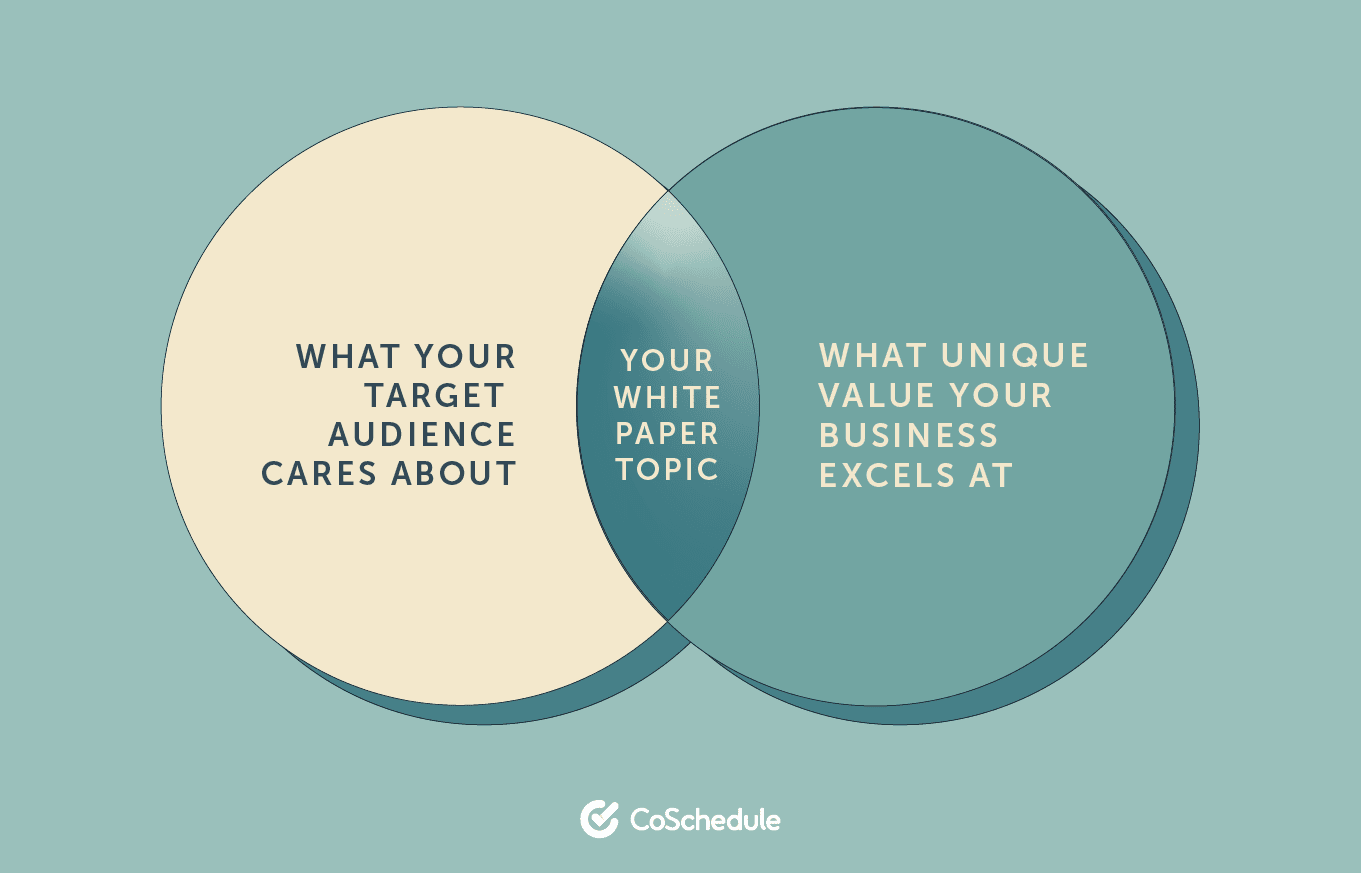
For the best chance of white paper success, choose topics that your business specializes in that your audience also cares about.
At CoSchedule, we call this approach
the content core. It balances your focus between traffic and promotion.
When you use the content core to decide on your white paper topics, everyone wins. Your customers get content they want to read, and you spread the word about your business.
And that combination leads to your ideal customers getting more info about your product,
taking them through the marketing funnel.
4. Research Your Topic
Start with internal research and gather all proprietary information that supports your topic. This includes:
- Results from your clients or customers, like customer success stories
- Unpublished customer interviews
- Anecdotes from your sales and customer service teams
- Audience surveys (for example, our marketing statistics report is based on a survey we ran)
- Quantitative data from your user base (for example, Mailchimp uses their user data to publish email marketing benchmarks)
- If you have the time and resources: your own research study (Andy Crestodina of Orbit Media Studios has a fantastic guide to get you started)
Then, jump into external research. This will depend on your industry, but here are some initial points to start:
Take note of everything that aligns with your topic. Right now, you can’t know which data points or examples you’ll use, so it pays off to keep track of anything interesting.
5. Define The Problem Your Audience Needs To Solve
Go back to the audience research you performed in the first step and think of problems your customers face that your white paper topic could solve. By understanding the issues your customers have related to your topic, you’ll be able to present your white paper as the solution.
Ask yourself these questions to find problems related to your topic that your audience faces:
- What knowledge gaps does my audience have in this topic?
- How does this topic challenge my audience in their business day-to-day?
- What worries about the future does my audience have related to this topic?
- What troubles does my audience have implementing this topic in their business?
6. Define The Solution Your White Paper Provides
Now that you know the issues your customers face related to your topic, you can create an angle for your white paper. Consider how you can share knowledge about your topic to solve your audience’s problem.
Let’s look at how Deloitte presents a solution in its
2022 Retail Industry Outlook white paper’s introduction.
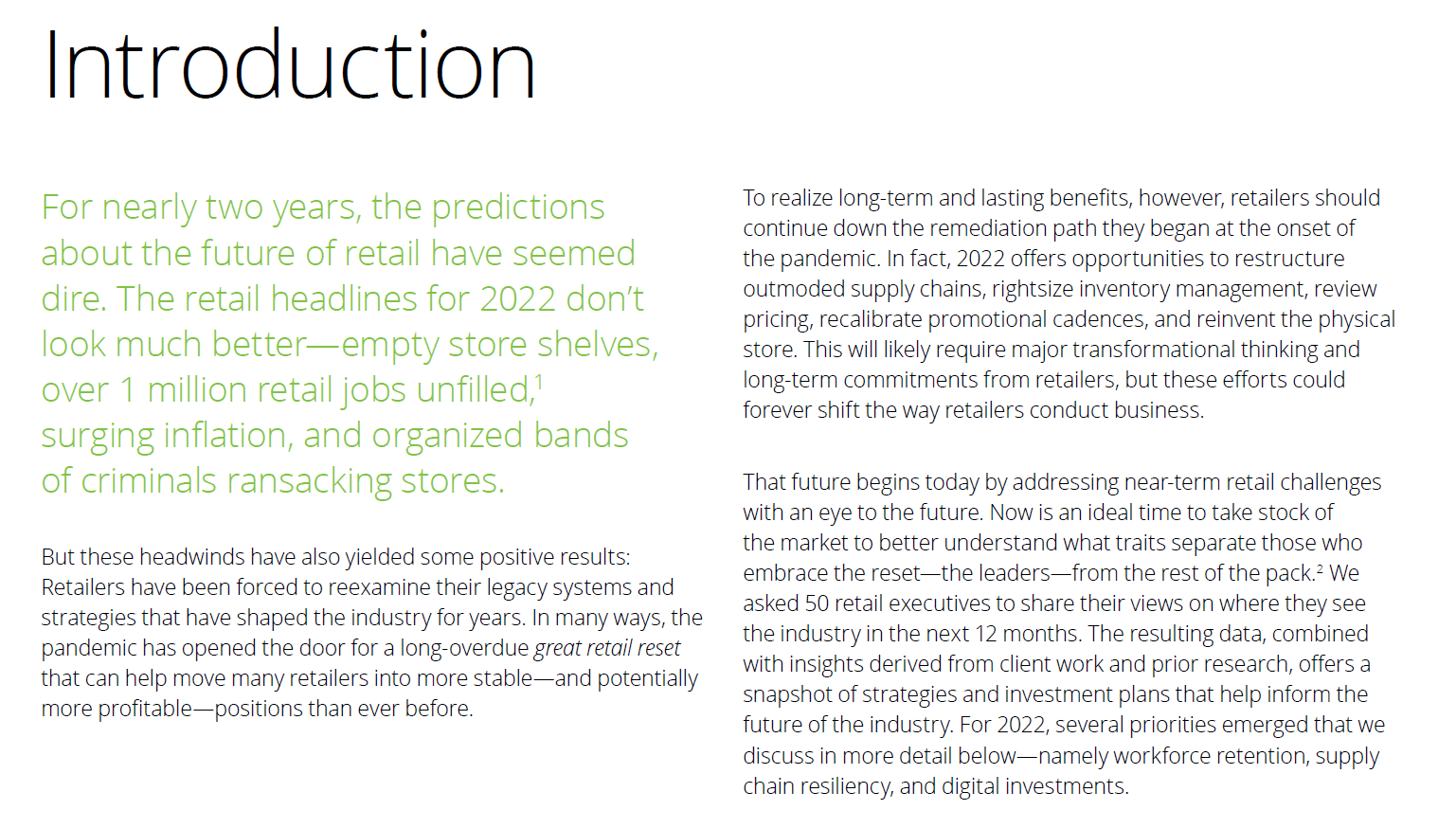
It starts by presenting the problem: Retailers need to keep transforming their businesses in the face of pandemic-fueled change.
Then, it provides the solution of informing retailers about 2022 trends so they can keep their businesses on the right course in the future.
Plan Your White Paper Writing & Formatting
7. Write Key Points In A White Paper Outline
Leave notes for yourself to cite references and sources. Writing from a
content outline helps you work faster and crush writer’s block.
Here’s how to build your white paper outline with the research you did so far:
- Headline: Start with a working version that describes your topic; you can always polish it up later. CoSchedule’s Headline Studio can help!
- An executive summary: A placeholder for a short description of what your white paper is about. Add key points here so you can build your summary later.
- Introduction: What is the hook that will draw your readers to keep reading the white paper? What are the main pain points and topics you’ll cover?
- Section subheadings: Each section is a point that supports your overall argument or a step in the process you’re presenting. Their subheadings should clearly introduce them.
- Subheading content: List the subpoints you're making in each section and any supporting information that you came across in your research.
- Conclusion: Summarize your key takeaways. If it’s appropriate, you might consider adding a call-to-action here, too.
Use our white paper template for the easiest way to build your white paper outline.
8. Get Inspiration From White Paper Examples
Want to get inspired by
white paper examples that work? Check out the list below and see how folks like Apple, Amazon, and Vox Media approach their white papers.
9. Stylize Your White Paper Document
Use this planning and outlining stage to also map out graphics, charts, sidebars, and one-pagers.
You can do this with text boxes, tables, and page breaks in the Word document. This way, you’ll have placeholders in place of visuals you’ll add in the design stage later on. This will help you shape your writing based on the skeleton of your white paper’s final look.
Additionally, use this step to adjust the appearance of your fonts and headers. In Microsoft Word, right-click the style you’re using, click Modify, and select different headings or paragraphs you want to update.

10. Write The White Paper Title
Best white paper headlines are those that connect your topic with an outcome your reader craves.
A strong headline includes:
- Word balance: a mix of common, uncommon, emotional, and power words
- Length: optimized for visibility and click-throughs on search engines and social media
- Type of headline: types of headlines include ‘“why” headlines, how-to, and question headlines
- Clarity and skimmability: simplified for easy reading and understanding at a glance
Start by listing headline options. Check out these
headline formulas and templates and
these 73 (!) ways to write a winning headline.
From there, jump into
Headline Analyzer Studio and check your strongest headline options against suggestions. Use the word bank to strengthen these headlines and pick your favorite to use in your white paper.
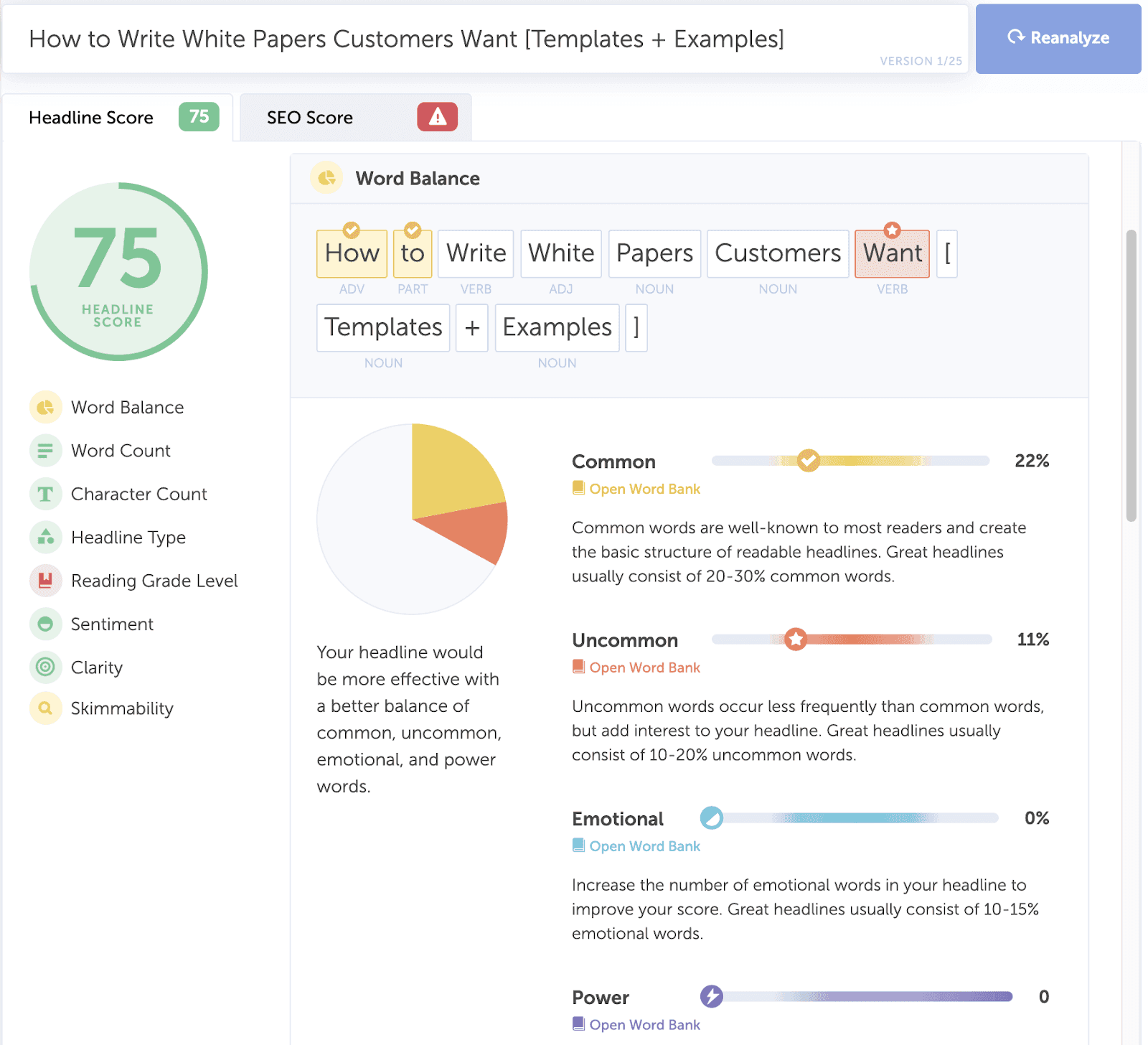
11. Write The White Paper Introduction
Your introduction bridges the promise from your headline and executive summary with the key points and sections of your white paper.
Best introductions help the reader:
- Feel like they’re in the right place, reading the right white paper based on the problem they want to solve
- Get a high-level overview of what you’ll cover
- Prove you do have the answers they’re looking for
Use your introduction to tease upcoming sections and touch on the data, resources, experts, and original research you’ll use to make your points.
12. Break Up White Paper Content With Subheadings & Subsections
Each subsection should make a distinct point, like defining a step of a process or making a specific argument.
If you’ve researched and outlined your white paper in an organized way, writing your white paper subsections should be relatively easy.
As you write, you might notice a gap in your research or a subsection that could be added based on the narrative you’re developing. If that happens, make a note and come back to it towards the end of your writing to fill those gaps.
13. Include Data & Visuals
Is there data or an idea that would be best presented visually?
Mark any segments that would benefit from a visual asset. You’ve marked some potential spots in your outline, so now that you have your draft, get specific about the exact visuals you need.
Think:
- A graph or chart of an important data point
- A one-pager with a key statistic or quote
- Comparison tables
- Custom illustrations
14. Recap The Problem & Solution In Your Conclusion
While white papers are a
type of marketing collateral, they often have a softer call-to-action than most others.
When your reader reaches the conclusion, they’ve just gone through a lot of info. Your conclusion should recap your white paper’s problem and solution to pull it all together and drive them to action.
Going back to Deloitte’s 2022 Retail Industry Outlook white paper, you can see a summary of the problem and solution in its conclusion.
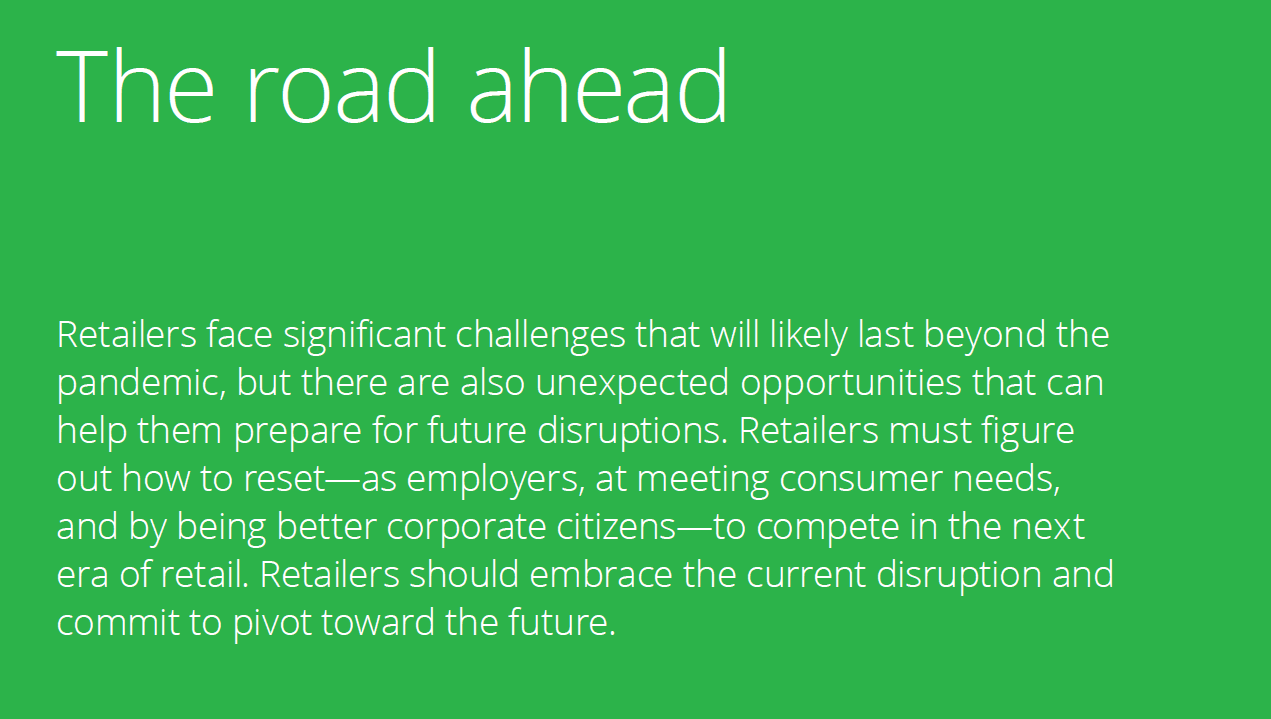
As you reflect on the retail insights you read in the white paper, the conclusion reminds you that retailers still face challenges, but they also have opportunities. It moves you forward by explaining how you can use the information you just learned to keep moving toward the future.
15. Proofread & Edit
With your first draft done, it’s time to review and edit your work—or hand it over to your editor, if you have one.
First, check the mechanics: grammar mistakes, spelling errors, passive voice, and similar issues. Tools like
Grammarly and
Hemingway are handy here.
Then, dig deeper to check the flow of your white paper and the strength of the points you’re making. This includes:
- Goal: Does the content fulfill its promise? Does it answer all the questions your reader might have?
- Structure: Is the structure optimized for engagement and completion?
- Facts: Is everything factually accurate? Double-check facts, statistics, links, and sources.
- Understanding: How easy is your writing to understand? If there is language or jargon your audience may not understand, note it and consider alternatives. This can be corrected with a simple search on Thesaurus.com.
Take note of any parts you need to reposition, phrase differently, or clarify; once you go through the entire document, jump into those edits. Grab some more
editing tips here if you need them.
You made it—you’re ready to research, plan, write, design, and promote an exceptional white paper.
Follow this process to build a piece of content that will serve your marketing and business goals for many months and years to come. Don’t skip the promotion and repurposing efforts to make your work go a long way.


 This means that your target reader needs different types of information within the same topic depending on whether they’re a leader or an implementer. Leaders need strategy and frameworks to think within, while implementers need hands-on tactics and directions.
To learn more about your target audience, we recommend reading:
This means that your target reader needs different types of information within the same topic depending on whether they’re a leader or an implementer. Leaders need strategy and frameworks to think within, while implementers need hands-on tactics and directions.
To learn more about your target audience, we recommend reading:
 During a SWOT analysis, you identify the strengths, weaknesses, opportunities, and threats your business faces. You can stick to the strengths and opportunities when you perform one to identify your expertise.
Think about the topics you know more about than your competition (strengths), and brainstorm subjects your competition doesn’t cover (opportunities).
During a SWOT analysis, you identify the strengths, weaknesses, opportunities, and threats your business faces. You can stick to the strengths and opportunities when you perform one to identify your expertise.
Think about the topics you know more about than your competition (strengths), and brainstorm subjects your competition doesn’t cover (opportunities).
 For the best chance of white paper success, choose topics that your business specializes in that your audience also cares about.
At CoSchedule, we call this approach the content core. It balances your focus between traffic and promotion.
When you use the content core to decide on your white paper topics, everyone wins. Your customers get content they want to read, and you spread the word about your business.
And that combination leads to your ideal customers getting more info about your product, taking them through the marketing funnel.
For the best chance of white paper success, choose topics that your business specializes in that your audience also cares about.
At CoSchedule, we call this approach the content core. It balances your focus between traffic and promotion.
When you use the content core to decide on your white paper topics, everyone wins. Your customers get content they want to read, and you spread the word about your business.
And that combination leads to your ideal customers getting more info about your product, taking them through the marketing funnel.
 It starts by presenting the problem: Retailers need to keep transforming their businesses in the face of pandemic-fueled change.
Then, it provides the solution of informing retailers about 2022 trends so they can keep their businesses on the right course in the future.
It starts by presenting the problem: Retailers need to keep transforming their businesses in the face of pandemic-fueled change.
Then, it provides the solution of informing retailers about 2022 trends so they can keep their businesses on the right course in the future.


 As you reflect on the retail insights you read in the white paper, the conclusion reminds you that retailers still face challenges, but they also have opportunities. It moves you forward by explaining how you can use the information you just learned to keep moving toward the future.
As you reflect on the retail insights you read in the white paper, the conclusion reminds you that retailers still face challenges, but they also have opportunities. It moves you forward by explaining how you can use the information you just learned to keep moving toward the future.


